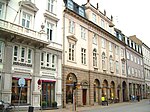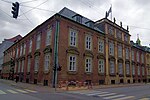Sankt Annæ Plads 5
1796 establishments in DenmarkListed residential buildings in CopenhagenNeoclassical architecture in CopenhagenResidential buildings completed in 1796

Sankt Annæ Plads 5 is a Neoclassical property constructed in 1796 by city builder Jørgen Henrich Rawert for his own use on the north side of Sankt Annæ Plads in central Copenhagen, Denmark. The building was a few years later used by him as a model for the design of the building at Sankt Annæ Plads 11 and most likely also for an adaption of the facade of the building at Amaliegade 45. It was listed on the Danish registry of protected buildings and places in 1918. The Danish Labour Court is now based in the building.
Excerpt from the Wikipedia article Sankt Annæ Plads 5 (License: CC BY-SA 3.0, Authors, Images).Sankt Annæ Plads 5
Sankt Annæ Plads, Copenhagen Christianshavn
Geographical coordinates (GPS) Address Nearby Places Show on map
Geographical coordinates (GPS)
| Latitude | Longitude |
|---|---|
| N 55.6823 ° | E 12.5896 ° |
Address
Sankt Annæ Plads 5
1250 Copenhagen, Christianshavn
Capital Region of Denmark, Denmark
Open on Google Maps











